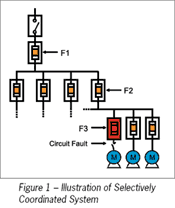System downtime is reduced when over current protective devices are selectively coordinated. Designers should strive to limit the outage to only that circuit which is overloaded or which has faulted in order to avoid shutting down healthy parts of the electrical distribution system.
Selectivity between over current protective devices is generally desirable and may be mandatory. Traditional time-current curve analysis may not accurately portray the degree of selectivity existing when current-limiting over current protective devices are involved.
This article will discuss viable methods for evaluating selectivity between current-limiting fuses and noncurrent-limiting circuit breakers.
What is Selective Coordination?
The following definition is found in Article 100 of the 2008 National Electric Code®, “Coordination (Selective). Localization of an over current condition to restrict outages to the circuit or equipment affected, accomplished by the choice of over current protective devices and their ratings or settings.”
A branch circuit over current protective device and its upstream feeder over current protective device are selectively coordinated if any possible over current passing through the branch device is cleared by the branch circuit device before the upstream feeder over current device opens.


Figure 1 illustrates the concept. F1 is our main fuse. F2 represents our feeder fuse and F3 is the branch circuit fuse. When a fault occurs within any portion of the F3 branch circuit, the short circuit current will pass through F1, F2, and F3. If our system is selectively coordinated, F3 will clear the fault before either F2 or F1 opens. If our system is not selectively coordinated, F2 and perhaps F1 may open as well as F3, unnecessarily de-energizing portions of the distribution system.
National Electric Code® (NEC) Requirements
Selective Coordination is mandated by the National Electric Code® for critical applications to minimize electrical hazards to personnel and to ensure continuity of power in areas where power is essential for safety. Specific applications include people movers, emergency and standby power systems and critical operations power systems relating to national security, the economy and public health or safety.
The following NEC articles require selective coordination.
- NEC Article 517 – Healthcare Facilities
- NEC Article 620 – Elevators, Dumbwaiters, Escalators, Moving Walks, Platform Lifts and Stairway Chairlifts
- NEC Article 700 – Emergency Systems
- NEC Article 701 – Legally Required Standby Systems
- NEC Article 708 – Critical Operation Power Systems (COPS)
Background Information
When non- current-limiting circuit breakers are downstream from current-limiting fuses, traditional time-current curve comparisons are appropriate for evaluating selectivity. However, a more detailed evaluation is necessary when current-limiting fuses are downstream from non- current-limiting circuit breakers. An understanding of how fuses and circuit breakers operate is a prerequisite to understanding why different evaluation approaches are needed.
Portions of this are article reprinted with the permission of Mersen USA, article authors Steve Hansen and Robert Lyons Jr.





